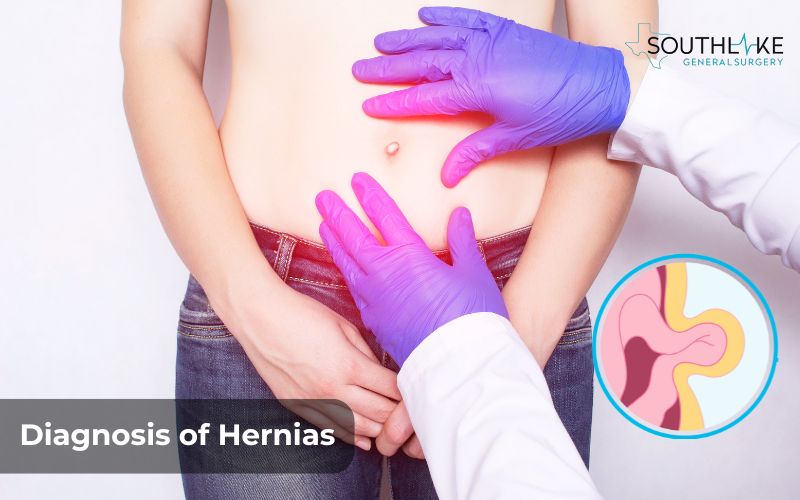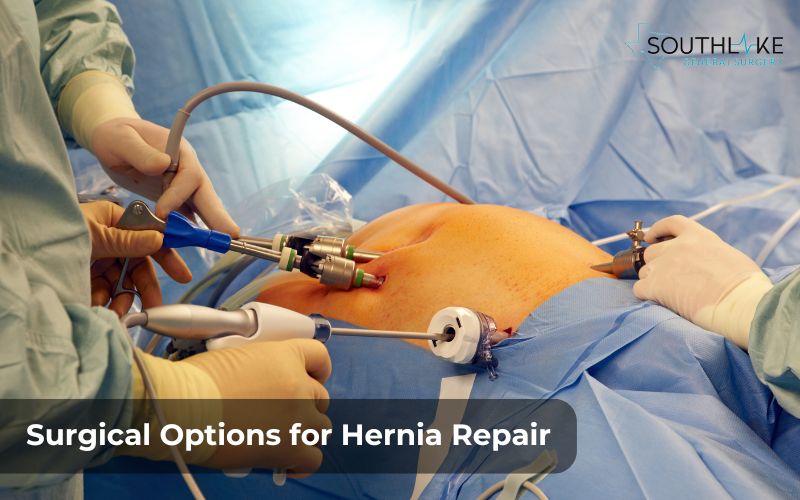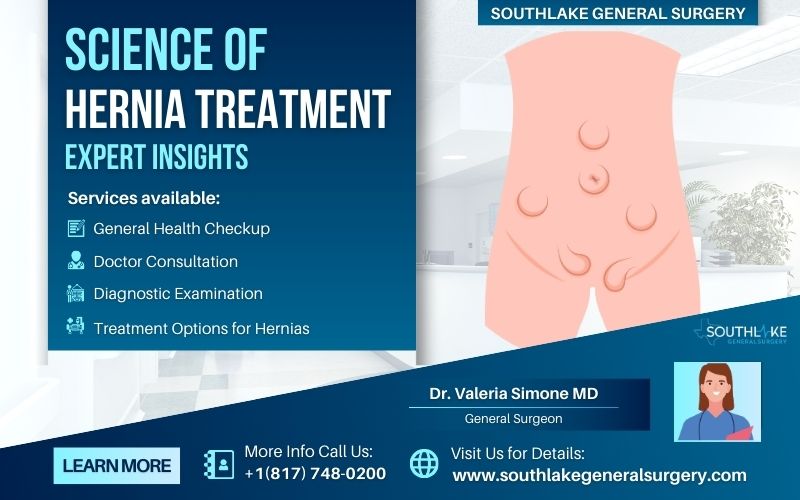Hernia treatment involves fixing the weak tissue in the abdominal wall, which can cause organs to push out. This procedure can be performed surgically to effectively close the opening and reinforce the area using hernia mesh.
The severity of the hernia and the patient’s general health determine how long it will take for them to recover.
Hernias are a common medical condition that occurs when an organ pushes through a weakened spot or tear in the muscle or tissue that holds it in place. While hernias can occur in different parts of the body, the most common types include inguinal hernias, umbilical hernias, and hiatal hernias.
- Inguinal hernias are common and happen in the groin area when the intestines push through a weak spot in the lower abdominal wall.
- Umbilical hernias occur near the belly button, mostly in infants and pregnant women.
- Hiatal hernias happen when part of the stomach moves up through the diaphragm into the chest cavity, causing symptoms like heartburn and swallowing issues.
Hernias can cause various symptoms, including a visible bulge in the affected area, discomfort or pain, and digestive issues. Treatment for hernia typically involves surgical repair, where the herniated tissue is pushed back into place and the weakened area is reinforced.
In some cases, non-surgical hernia treatment, lifestyle changes, and watchful waiting may be recommended to prevent further tissue pushes and potential complications.
In this blog, we will look at how hernias are treated and share expert views on causes, types, symptoms, diagnosis, and treatment choices. We will also talk about stopping hernias and offer tips for lowering the chances of getting one.
If you want to know more about hernias for yourself or someone else, this blog can help you learn more and decide on healthcare wisely.
Key Highlights
- Hernias can develop when an organ protrudes through a vulnerable area or tear in the muscle or tissue that normally keeps it secure.
- Several types of hernias are commonly seen, such as inguinal hernias, umbilical hernias, and hiatal hernias.
- Hernias can cause symptoms such as a visible bulge, discomfort or pain, and digestive issues.
- Treatment for hernia often involves surgical repair to push the herniated tissue back into place and reinforce the weakened area.
- Lifestyle changes, such as weight management and avoiding heavy lifting, can help prevent hernias.
- It’s important to seek medical attention for hernias, as complications can arise if left untreated.
Understanding Hernias: Causes and Types
Hernias can occur when an internal organ or tissue pushes through a weakened area in the abdominal wall. Common triggers include heavy lifting, obesity, and abdominal surgery. Various types of hernias exist, such as inguinal, umbilical, and hiatal hernias.
Hernias, generally inguinal hernias, commonly develop in the groin area. Understanding these causes and types is crucial for early detection and appropriate treatment options.
What Causes a Hernia? Insights into Common Triggers
Hernias can be triggered by factors like heavy lifting, persistent coughing, obesity, and pregnancy. These actions strain the abdominal muscles, leading to a weakened area where organs may bulge through. Understanding these common triggers is crucial for hernia prevention.
Different Types of Hernias Explained

One of the most common types is an inguinal hernia, the most common type of hernia overall. It occurs in the inguinal canal in the groin area and is often seen in men due to the passage of the spermatic cord from the abdomen to the scrotum.
Umbilical hernias occur when the abdominal wall weakens and protrudes around the belly button. Incisional hernias occur when the intestines protrude through the incision left behind by abdominal surgery.
Ventral hernias are observed in the lower abdominal wall, while femoral hernias appear in the upper thigh. Understanding these variations is crucial for effective hernia treatment.
Symptoms of Hernias to Watch For

- Lifting heavy objects or exercising vigorously can cause chronic hernia pain.
- Noticing a visible bulge in the groin or abdominal area should raise concerns.
- You should see a doctor if you experience any kind of swelling or pain that doesn’t go away or gets worse with time.
- In some cases, hernias can present with nausea, vomiting, or constipation due to the part of the intestine getting trapped.
Being vigilant about these signs is crucial for timely diagnosis and appropriate hernia treatment.
Early Warning Signs of a Hernia
Hernias may manifest with subtle early warning signs such as discomfort or a noticeable bulge in the abdominal or groin area. These early symptoms shouldn’t be ignored, as they could indicate a hernia. Pay attention to any persistent pain or heaviness in the affected area, especially during activities like lifting heavy objects.
If you notice any abnormal bulging or protrusion, it is important to seek medical attention promptly to prevent any potential complications. Early detection plays a crucial role in successful hernia treatment.
When Symptoms Warrant a Doctor’s Visit
Seek medical attention if experiencing severe hernia pain, sudden swelling, or redness over the hernia site. Persistent pain or a noticeable bulge that doesn’t recede or worsens warrants prompt evaluation by a healthcare professional.
Additionally, if the hernia becomes tender and firm, or you have trouble passing stools or gas, it’s crucial to consult a doctor.
Immediate medical assessment is essential if you observe symptoms of bowel obstruction, such as nausea, vomiting, and the inability to have a bowel movement, as this may indicate the need for emergency surgery.
Diagnosis of Hernias: What to Expect

During the diagnosis of hernias, expect a comprehensive assessment involving physical examinations and imaging tests. Physicians may palpate the abdominal area to identify any abnormalities, examining for a noticeable bulge or tenderness.
Additionally, imaging techniques such as CT scans may be utilized to visualize the hernia.
These diagnostic steps aid in determining the type and severity of the hernia, guiding treatment decisions effectively. The development of an individualized treatment plan begins with an accurate diagnosis.
The Role of Physical Examination in Diagnosing Hernias
Physical examination plays a crucial role in diagnosing hernias. By palpating the affected area, healthcare providers can often detect a noticeable bulge or abnormality. As an additional pain-relieving measure, they may apply pressure.
To further evaluate the hernia’s size and location, the examination might include targeted maneuvers.
This hands-on approach, coupled with a patient’s medical history, helps healthcare professionals determine the presence and extent of a hernia accurately, guiding further diagnostic steps if needed.
Imaging Tests Used in Hernia Diagnosis
Accurately diagnosing hernias relies heavily on imaging tests. Among the common tests used are ultrasound, which provides real-time imaging, and CT scans, offering detailed cross-sectional views. These tests help in identifying the hernia’s size, location, and any complications, such as incarcerated hernias.
In some cases, MRI may be utilized for a more detailed assessment of the herniated area. Imaging tests aid healthcare providers in planning appropriate treatment strategies for optimal patient care.
Treatment Options for Hernias
Hernia treatment options vary based on the type and severity of the condition. Non-surgical approaches like lifestyle modifications, weight management, or trusses may suffice for some patients.
However, hernia repair through surgical intervention becomes necessary in many cases. Surgical methods include traditional open surgery or minimally invasive laparoscopic procedures.
The choice between these options depends on factors such as the type of hernia, the patient’s health status, and the surgeon’s recommendation.
Non-Surgical Treatments and Their Efficacy
Non-surgical treatments for hernias focus on managing symptoms and preventing complications without surgical intervention. These methods may include lifestyle adjustments, such as avoiding heavy lifting, and the use of hernia trusses or supports to provide temporary relief.
While non-surgical approaches can help alleviate discomfort and reduce the risk of complications in some cases, they may not provide a permanent solution for hernia repair. To find the best course of treatment, it’s important to talk to a doctor.
Surgical Options for Hernia Repair

When hernia repair is needed, surgical options come into play. There are two primary surgical procedures for repairing hernias: open surgery and laparoscopic hernia repair surgery.
Open surgery involves a larger incision, while laparoscopic surgery uses smaller incisions and specialized tools for repair.
Laparoscopic surgery, also known as minimally invasive surgery, typically results in less pain and a quicker recovery time compared to open surgery. To guide the hernia repair surgery, the surgeon will make multiple small incisions and insert a laparoscope, which is a thin tube with a video camera attached.
Considerations such as the patient’s health and the kind of hernia dictate which of these approaches is best. Surgeons will recommend the most suitable approach for optimal results.
Hernia Surgery: A Closer Look
Hernia surgery involves repairing the weakened abdominal wall to address various types of hernias. Whether it’s an inguinal, umbilical, or incisional hernia, surgical repair is often necessary, especially in the presence of complications like an incarcerated hernia. Under general anesthesia, procedures may involve open or laparoscopic surgery.
Understanding the specific type of hernia and the surgical approach, such as inguinal hernia repair, is crucial for a successful outcome. Discussing the details with a healthcare provider will provide clarity on the process and expectations.
Preparing for Hernia Surgery: Steps and Tips
Prior to hernia surgery, follow instructions provided by your healthcare team meticulously. Be prepared for potential fasting requirements leading up to the procedure.
Please ensure that all the required arrangements are made for transportation to and from the surgical facility.
Familiarize yourself with post-operative care instructions to aid in a smoother recovery process. Communicate any concerns or questions you may have with your healthcare provider promptly to alleviate any anxieties pre-surgery.
Remember, proper preparation is key to a successful surgical experience.
Innovative Surgical Techniques in Hernia Repair
Innovative surgical techniques in hernia repair involve advanced approaches like laparoscopic surgery, which offer benefits such as smaller incisions, reduced post-operative pain, and quicker recovery times.
These minimally invasive techniques use specialized tools and a camera to repair the hernia with precision and minimal invasion, resulting in better cosmetic outcomes.
Additionally, robotic-assisted hernia repairs are gaining popularity for their enhanced dexterity and visualization, allowing surgeons to perform intricate procedures with improved accuracy and patient outcomes.
This type of surgery, including laparoscopy and robotic-assisted repair, is becoming the preferred treatment for hernias due to its many advantages over traditional open repair methods.
Recovery After Hernia Surgery
After hernia surgery, recovery involves adequate rest and following post-operative instructions for optimal healing. Patients usually experience some discomfort, swelling, and restricted activities initially.
To ease any pain, a doctor may prescribe medication for pain management. Gradual resumption of light activities is recommended, with a focus on avoiding heavy lifting.
Surgical wounds need to be kept clean and dry to prevent infections. Follow-up appointments with the surgeon are essential to monitor progress and address any concerns promptly.
Post-Surgery Care and Management
After hernia surgery, post-surgery care and management are crucial for a successful recovery. Patients must follow their doctor’s instructions regarding wound care, physical activity, and pain management.
Keep an eye out for any redness, swelling, or discharge at the incision site; these could be symptoms of infection. You can consult a doctor immediately if you experience any unusual symptoms or you can book an appointment with Dr. Valeria Simone MD.
Maintaining a healthy lifestyle, including proper nutrition and avoiding strenuous activities, can aid in the healing process and minimize the risk of complications.
Postoperative follow-up appointments are necessary to monitor progress and ensure optimal recovery.
Long-Term Recovery and Lifestyle Adjustments
After hernia repair, focusing on long-term recovery is crucial. Lifestyle adjustments play a key role in preventing hernia recurrence.
Gradual return to physical activities, avoiding heavy lifting, and maintaining a healthy weight are paramount. Understanding your body’s limitations post-surgery is vital for a successful recovery.
Incorporating regular exercise to strengthen abdominal muscles and following a balanced diet can aid in long-term management.
Seeking medical guidance on appropriate lifestyle modifications ensures a smoother path to full recovery and reduces the risk of future complications.
Risks and Complications of Hernia Treatments
Complications from hernia treatments may include infection, recurrence, or nerve damage. Surgery can entail risks such as bleeding, blood clots, or adverse reactions to anesthesia.
In rare cases, serious complications like bowel obstruction or hernia recurrence post-surgery can occur, potentially leading to a loss of blood supply to the affected tissue.
Understanding these risks and promptly addressing any concerns with your healthcare provider is crucial for a successful treatment journey.
Understanding Potential Surgical Risks
Potential surgical risks associated with hernia repair include infection, bleeding, and nerve damage. Mesh placement can lead to complications like mesh migration or contraction.
It is uncommon, but there is a slight chance of experiencing adverse reactions to anesthesia. Chronic pain post-repair is another concern.
In some cases, hernias can reoccur, necessitating further surgery. Careful consideration of these risks is crucial before opting for hernia repair.
Seeking expert medical advice ensures a comprehensive understanding of the potential surgical complications. Stay informed for a smoother recovery process.
Managing and Mitigating Post-Surgical Complications
After hernia surgery, managing and mitigating post-surgical complications are crucial. Ensuring proper wound care, following physician instructions diligently, and monitoring for any signs of infection or unusual symptoms are paramount. Promptly seeking medical attention for any concerning issues is essential in preventing complications.
Additionally, maintaining a healthy lifestyle, including a balanced diet and regular exercise, can aid in a smoother recovery process.
By adhering to post-operative guidelines and staying vigilant, patients can reduce the risk and severity of post-surgical complications, promoting a successful outcome.
Preventing Hernias: Practical Advice

Maintaining a healthy lifestyle is crucial in preventing hernias. Avoid straining during bowel movements and lifting heavy objects.
You can further lower your risk by exercising regularly to build your abdominal muscles. Maintain a healthy weight to lessen pressure on your abdomen. Ensure proper form during workouts and use support when needed.
If you smoke, consider quitting, as it can weaken connective tissues. Be mindful of your body mechanics in daily activities to protect your lower abdomen from strain.
Lifestyle and Dietary Changes to Lower Risk
You can reduce your risk of hernias by making changes to your diet and way of life. Maintaining a healthy weight through balanced nutrition and regular exercise is key.
Avoiding heavy lifting and practicing proper lifting techniques can also reduce the strain on your abdominal muscles, decreasing the likelihood of developing a hernia.
Ensuring a diet rich in fiber to prevent constipation, which can lead to increased abdominal pressure, is beneficial in hernia prevention.
Staying hydrated and incorporating foods high in vitamins and minerals can support overall abdominal health.
Importance of Regular Exercise and Weight Management
Regular exercise and maintaining a healthy weight play a crucial role in preventing hernias. Strengthening the abdominal muscles through targeted exercises can help support the abdominal wall, reducing the risk of hernia development.
Additionally, managing weight effectively can ease pressure on the abdominal area, decreasing the likelihood of strain and potential hernias.
By incorporating regular physical activity and maintaining a balanced weight, individuals can actively lower their risk of hernias, promoting overall well-being and abdominal health.
Outlook
We typically see a positive outlook following hernia treatment. Recent developments in hernia repair methods, such as laparoscopic surgery, have resulted in shorter recovery periods and improved patient comfort. Following post-operative care instructions and making necessary lifestyle adjustments can further enhance the recovery process.
While hernia surgery may have risks and complications, the overall success rate is high, particularly when promptly addressed. By seeking medical attention for hernia symptoms and adhering to recommended treatments, individuals can expect a favorable outlook towards a hernia-free future.
Make An Appointment
To schedule your appointment with Dr. Valeria Simone MD at Southlake General Surgery in Texas, USA, please call +1 (817) 748-0200.
Dr. Simone specializes in hernia treatment and offers expert care for hernia repair procedures. Don’t delay in seeking medical attention for your hernia symptoms; book your consultation today for personalized treatment options and comprehensive care.
Frequently Asked Questions
Can Hernias Heal Without Surgery?
Unfortunately, surgical repair is usually necessary for hernias. Managing symptoms is possible with non-surgical methods, but they won’t fix the hernia. To get the right diagnosis and treatment options, it’s essential to see a doctor.
What Are the Signs of a Hernia Requiring Immediate Medical Attention?
Common signs of a hernia needing urgent medical care include severe pain, sudden swelling, vomiting, and the inability to pass gas or stools. Seek medical help right away if you notice any of these signs and symptoms.
Medically Reviewed By: Dr. Valeria Simone MD
Board-certified General Surgeon at Southlake General Surgery, Texas, USA.
Follow us on Facebook and YouTube.
References:
- “Umbilical Hernia.” StatPearls – NCBI Bookshelf, 27 Feb. 2024, www.ncbi.nlm.nih.gov/books/NBK459312.
- “Ventral Hernia.” StatPearls – NCBI Bookshelf, 8 Aug. 2023, www.ncbi.nlm.nih.gov/books/NBK499927.
- “Pediatric Umbilical Hernia.” StatPearls – NCBI Bookshelf, 18 Nov. 2023, www.ncbi.nlm.nih.gov/books/NBK459294.
- “Modifying Risks in Ventral Hernia Patients With Prehabilitation.” Annals of Surgery, vol. 268, no. 4, Oct. 2018, pp. 674–80. https://doi.org/10.1097/sla.0000000000002961.
- “Ventral hernia and pregnancy: A systematic review.” the American Journal of Surgery, vol. 217, no. 1, Jan. 2019, pp. 163–68. https://doi.org/10.1016/j.amjsurg.2018.04.016.
- National Institute of Diabetes and Digestive and Kidney Diseases, 9 Dec. 2021, www.niddk.nih.gov/health-information/digestive-diseases/inguinal-hernia.

